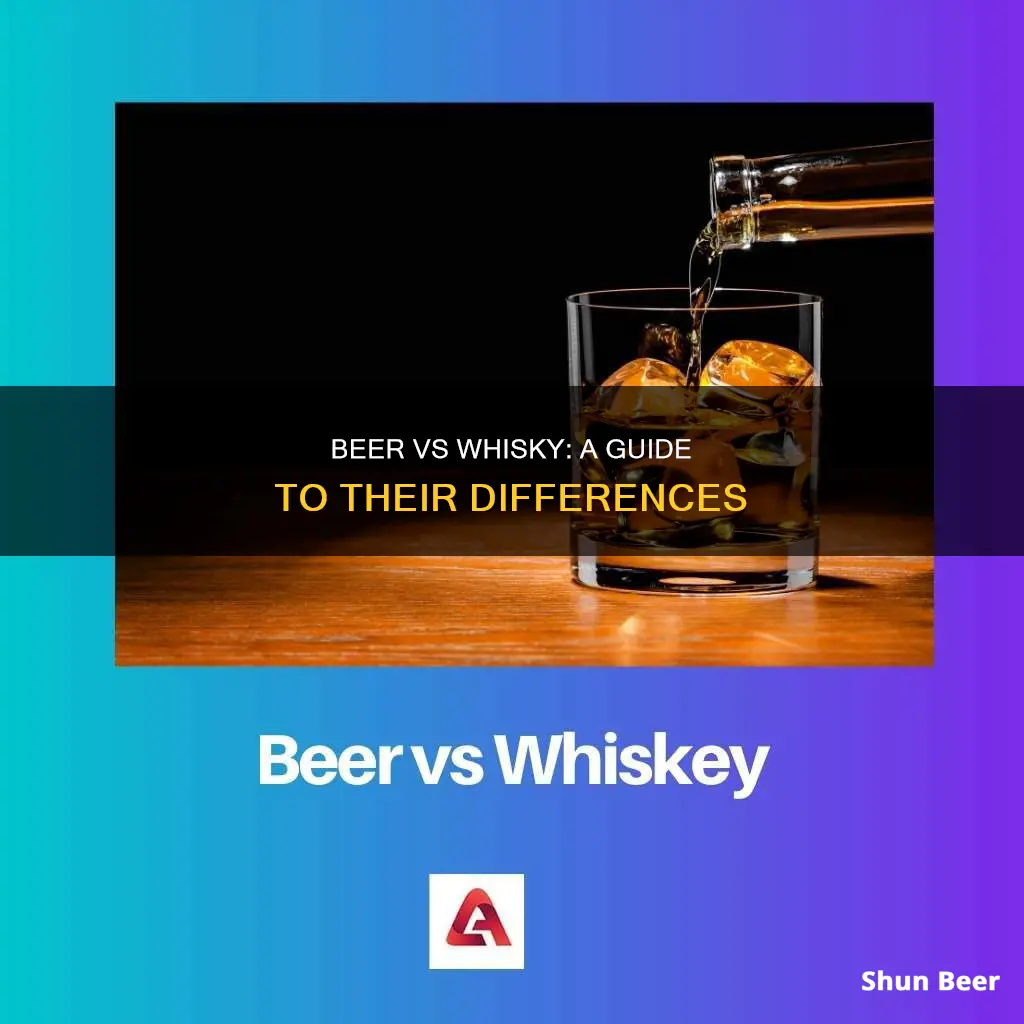
Beer and whiskey are two alcoholic beverages with distinct characteristics. While both drinks share some similarities in their production process and ingredients, they differ significantly in terms of alcohol concentration, taste, appearance, and health implications. Understanding these differences is essential for consumers to make informed choices and practice responsible drinking. This paragraph aims to provide an overview of the key distinctions between beer and whiskey, highlighting their unique attributes and the impact they have on the drinking experience and health.
Differences Between Beer and Whisky
| Characteristics | Values |
|---|---|
| Alcohol Concentration | Whisky has a higher alcohol concentration, typically around 40% ABV, while beer ranges from 4% to 11% ABV. |
| Production Process | In whisky, yeast is added to wort for fermentation, while in beer production, hops are added to yeast for fermentation. |
| Ingredients | Both drinks share the same three ingredients: water, barley, and yeast. However, whisky is distilled from beer, removing many compounds and concentrating the alcohol. |
| Taste | Beer often comes in different flavors, including fruity sours, hoppy IPAs, or heavy stouts, while whisky is marked by notes of caramel, spice, and slight sweetness. |
| Health Impact | Whisky is considered more harmful due to its high concentration of ethanol, which has been linked to cancer risks. Beer contains nutrients like B vitamins, potassium, and biotin and is believed to have heart-protecting compounds. |
| Appearance | Whisky is clear in color when distilled and turns brown during the ageing process in wooden casks. Beer does not undergo a similar color change. |
| Price | Beer is generally cheaper than whisky. |
What You'll Learn

Whisky is distilled from beer, with a higher ABV
Whisky and beer are both alcoholic beverages with distinct characteristics. While they share some similarities, one notable difference is that whisky is distilled from beer and has a higher alcohol content, often reflected in its higher ABV (Alcohol by Volume).
The process of distillation plays a crucial role in transforming beer into whisky. Distillation involves separating the components of a liquid mixture through selective boiling and condensation. In the context of alcohol production, distillation serves to increase the concentration of ethanol, resulting in a higher ABV.
Beer typically undergoes fermentation, where yeast is added to the wort (a mixture of water and grains) to convert sugars into alcohol. This process results in a relatively lower alcohol content compared to whisky. Most beers have an ABV ranging from 4% to 6%, with some double hopped pale ales reaching nearly 11%.
On the other hand, whisky is created by distilling beer, which involves taking an already fermented beer and further concentrating its alcohol content. This distillation process significantly increases the ABV, with whiskies typically reaching 40% ABV or higher.
The higher ABV in whisky contributes to its unique taste and sensory experience. The distillation process not only increases the alcohol content but also removes many of the compounds present in the initial liquid, giving whisky its distinct flavour profile. Additionally, the maturation process, where whisky is aged in wooden casks, further enhances its flavour, as compounds leach from the wood, imparting colour and additional flavours, such as notes of caramel, spice, and slight sweetness.
It is important to note that while whisky is distilled from beer, the "beer" used in whisky-making is not typically meant for drinking. This beer is brewed specifically for properties that will produce a good whisky, rather than for taste.
Malt Beverage vs Beer: What's the Difference?
You may want to see also

Whisky is aged in wooden casks, beer is not
Whisky and beer are two very different drinks, despite both containing water, barley, and yeast. Whisky is a distilled spirit, whereas beer is not. Distillation increases the alcohol concentration in whisky, and the spirit is then aged in wooden casks, which gives whisky its colour and flavour. Beer, on the other hand, is a fermented drink that does not undergo distillation or ageing in wooden casks.
Whisky maturation is a complex process that involves several parameters, including time, oak species, cask freshness, cask provenance, and climate. The type of wood used for the casks, as well as their age and size, can significantly impact the final flavour of the whisky. For example, American oak imparts sweeter notes such as vanilla and coconut, while European oak gives spicier notes like dried fruits and cinnamon.
The casks used for ageing whisky are typically made of oak and can be new or previously used for maturing other spirits or wines. The previous liquid in the cask can also influence the flavour of the whisky. For instance, a cask that previously held bourbon will impart different flavours than one that held sherry or wine.
The ageing process in wooden casks is an essential step in whisky-making, as it enhances the spirit's flavour and gives it its distinctive characteristics. The interaction between the wood, spirit, and residuals from previous fillings results in new flavours and aromas. Additionally, the charcoal inside the cask helps to mellow sharp flavours from the distillation.
In summary, whisky is aged in wooden casks, which is a crucial step in its production, while beer does not undergo this ageing process. This ageing process imparts unique flavours and characteristics to whisky, making it distinct from beer.
Beer Strength Differences: 3.2 vs. 6 ABVs
You may want to see also

Whisky is clear before ageing, beer is not
Whisky and beer are two very different drinks, despite both including the same three base ingredients: water, barley, and yeast. One of the most notable differences between the two is that whisky is clear before ageing, whereas beer is not.
Whisky is a distilled spirit, typically made from fermented barley. The distillation process involves heating the fermented barley mixture to evaporate the alcohol, which is then collected and condensed back into a liquid. This results in a clear, colourless liquid with a high alcohol content. This clear spirit is then aged in wooden barrels, typically made of oak, which gives whisky its characteristic golden-brown colour and unique flavour. The ageing process can last for several years, and the longer the whisky ages, the more complex its flavour becomes.
On the other hand, beer is a fermented beverage with a lower alcohol content compared to whisky. The fermentation process involves converting sugars from the barley into alcohol, resulting in a cloudy, golden-coloured liquid. Unlike whisky, beer does not undergo distillation or ageing in wooden barrels. Instead, beer is often flavoured with hops, which adds bitterness and aroma, resulting in a variety of flavours and lightness, including fruity sours, hoppy IPAs, or heavy stouts.
The clear colour of whisky before ageing is due to the distillation process, which removes impurities and concentrates the alcohol. The ageing process then adds colour and flavour to the whisky, with the wooden barrels imparting their characteristic golden-brown hue and notes of oak, vanilla, and spice.
In summary, whisky is clear before ageing because it has undergone distillation, a process that purifies the alcohol and removes its colour. Beer, on the other hand, is not clear because it does not undergo the same distillation process and retains its cloudy, golden appearance. The ageing process in wooden barrels is what gives whisky its distinctive colour and flavour profile, setting it apart from the lighter and less complex beer.
Beer vs Spirits: Understanding Alcoholic Beverage Differences
You may want to see also

Whisky is a spirit, beer is not
Whisky and beer are both made from starchy grains, such as wheat, barley, rye, millet, oats and corn. However, whisky is a distilled spirit, and beer is not.
Whisky is a distilled spirit made from fermented barley. It is typically aged in wooden cases or casks before bottling, which contributes to its flavour. Whisky often has a high ABV of over 40%. The maturation process in wooden casks gives whisky its colour and flavour. The ""beer" that goes into whisky is not really drinkable; it is brewed for properties that will produce good whisky.
Beer, on the other hand, is the fermented, alcoholic product of water, barley, and yeast. Its alcoholic content often varies from four to nearly eleven per cent, depending on the type. Beer often comes in different flavours and lightness, including fruity sours, hoppy IPAs, or heavy stouts. There are two types of beer: lager and ale.
Whisky is a spirit, and beer is not. This is a key difference between the two drinks, and it results in several other distinctions. The production process for whisky involves adding yeast to wort for fermentation, while beer production involves adding hops to yeast for fermentation. This creates the higher ABV of whisky, as well as its unique taste. Whisky is also typically aged in wooden cases, which contributes to its flavour.
Crunchy Coatings: Tempura vs Beer Batter
You may want to see also

Whisky and beer are made from different grains
Whisky and beer are indeed made from different grains. Whisky is typically made from malted barley, maize, wheat, and rye, whereas beer is made from barley, wheat, rice, corn, oats, and rye.
Historically, some of the first whiskies were made entirely from barley, and most barley whiskies are malted. The malting process involves making the barley sprout to create enzymes, which convert the carbohydrates into simple sugars that can be fermented by yeast to produce alcohol. The malting process is also used for barley and wheat in the production of beer. However, other grains used in beer, such as rice, corn, and oats, do not require malting.
The grains used in whisky production can vary depending on the type of whisky and the region of production. For example, American whiskey often contains corn, as it is required to make bourbon. On the other hand, rye whiskey is favoured for its spicy flavour, with notes of black pepper, rye bread, or anise.
In contrast, beer grains are chosen for their unique effects on the flavour, aroma, colour, and texture of the final product. For example, corn in beer provides a smooth and neutral sweetness, while oats create a creamy, full-bodied brew. Rice is used to create a dry profile and lighten the body of the beer.
Stroh's Beer: Unique Characteristics and Distinctions
You may want to see also
Frequently asked questions
Beer typically has an alcohol content of 4-11%, while whisky has a much higher alcohol content of around 40-60%.
Beer is made from water, barley, hops, and yeast. Whisky is made from fermented grain mash, typically including barley, corn, rye, or wheat.
Beer is a fermented beverage, while whisky is a distilled beverage. Beer is produced by adding malted barley or malted wheat to hot water to create a mash, then boiling and filtering the liquid before adding yeast and leaving it to ferment. Whisky is produced by fermenting a mash of grain, then distilling the mixture and ageing it in wooden barrels.
Whisky is a stronger drink than beer and is therefore more harmful to health. It contains ethanol, which can cause cancer. Beer, on the other hand, contains nutrients such as B vitamins, potassium, and biotin, and has been linked to lower cholesterol levels and relief from menstrual cramps. However, both drinks should be consumed in moderation.







